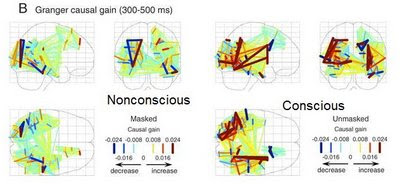 There’s a new paper out in PLoS on locating consciousness within the brain. Basically, they used electrodes to measure neural activity in patients undergoing treatment for epilepsy while they were shown words that were either ‘blipped’ on screen (so they never became conscious of them) or shown for longer times.
There’s a new paper out in PLoS on locating consciousness within the brain. Basically, they used electrodes to measure neural activity in patients undergoing treatment for epilepsy while they were shown words that were either ‘blipped’ on screen (so they never became conscious of them) or shown for longer times.
The key question was: is there somewhere in the brain that needs to be activated to trigger consciousness, or is it that consciousness happens when the level of brain activity reaches a critical threshold. This is the ‘Global Workspace’ model of consciousness, and this new study strongly supports it.
The key idea behind the workspace model is that because of its massive interconnectivity, the active coherent assembly of workspace neurons can distribute its contents to a great variety of other brain processors, thus making this information globally available. The global workspace model postulates that this global availability of information is what we subjectively experience as a conscious state. (Gaillard et al)
The figure I’ve pulled out shows Grainer Causality, which is a mathematical tool used to estimate the causal influence that one electrode site exerts on another. If Global Workspace theory is right, then conscious awareness should result in a massive web of causal relationships among distant sites in the brain. And this is what happened. When large areas of the brain became synchronised, consciousness occurred.
I think these results help to break down dualist ideas separating the mind (or soul) from the brain. Religious belief almost always goes hand in hand with dualism. I’m plodding my way through Keith Ward’s book “Why there almost certainly is a God”. He’s a smart man (a former professor of Divinity at Oxford), and he thinks that minds can lead a life independent of the brain:
The existence of consciousness refutes radical materialism, the theory that nothing exists except physical things in space and time. But emergent materialism, the theory that minds arise from matter, even though they are not just material, is more plausible. However, if you are an emergent materialist, you have already taken the first step to forming some idea of God. You have said that not everything is a physical object in space.
All this passage demonstrates is that Ward can’t get his head round the idea of emergent properties. Weather is an emergent property. Doesn’t mean that it doesn’t exist as a physical object. Emergent properties are information. All Ward is doing is falling for the age-old human error of confusing emergence with magic. It’s the modern-day equivalent of primitive animism.
I think, from reading his book, that Ward knows deep down that neuroscience will continue to chip away at the hiding places for animism.
Martha Farah and Nancey Murphy, a neuroscientist and a theologian respectively, made this point in a recent letter to Science magazine:
… as neuroscience begins to reveal the mechanisms underlying personality, love, morality, and spirituality, the idea of a ghost in the machine becomes strained. Brain imaging indicates that all of these traits have physical correlates in brain function. Furthermore, pharmacologic influences on these traits, as well as the effects of localized stimulation or damage, demonstrate that the brain processes in question are not mere correlates but are the physical bases of these central aspects of our personhood. If these aspects of the person are all features of the machine, why have a ghost at all? (free text here)
Now, neurocorrelates are not the same as an explanation. A fundamental barrier to scientific explanations of consciousness is that philosophers can’t define it. In fact, it may never be definable or explainable, but this is not a reason to invent dualist explanations, however tempting.
I like Farah & Murphy’s conclusion:
… it seems likely that neuroscience will pose a far more fundamental challenge than evolutionary biology to many religions. Predictably, then, some theologians and even neuroscientists are resisting the implications of modern cognitive and affective neuroscience. “Nonmaterialist neuroscience” has joined “intelligent design” as an alternative interpretation of scientific data.
_____________________________________________________________________________________
![]() Gaillard, R., Dehaene, S., Adam, C., Clémenceau, S., Hasboun, D., Baulac, M., Cohen, L., & Naccache, L. (2009). Converging Intracranial Markers of Conscious Access PLoS Biology, 7 (3) DOI: 10.1371/journal.pbio.1000061
Gaillard, R., Dehaene, S., Adam, C., Clémenceau, S., Hasboun, D., Baulac, M., Cohen, L., & Naccache, L. (2009). Converging Intracranial Markers of Conscious Access PLoS Biology, 7 (3) DOI: 10.1371/journal.pbio.1000061













